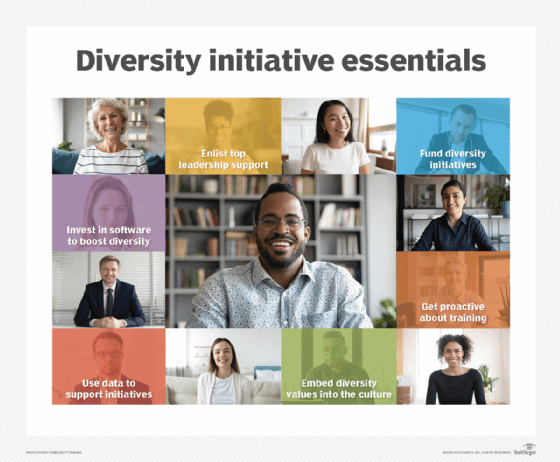
14 types of diversity in the workplace
Diversity can help improve a company's bottom line, but the term often causes confusion. Learn about the different types and how to use them to build a supportive work environment.
Employees deserve a work environment where everyone feels valued for their contributions. So, it's critical for every employee, regardless of their position, to recognize the importance of diversity at work.
Diversity, equity and inclusion (DEI) can have a profound effect on a workplace. When ignored, it can result in an exclusionary environment. Companies that embrace diversity can cultivate a respectful workforce that celebrates creativity and different perspectives while fostering more engaged, satisfied and productive employees.
To fully understand workplace diversity, it's critical to recognize the various types of diversity that employees might encounter. Those types can include the following:
- Race, ethnicity and national origin.
- Culture.
- Gender.
- Gender expression.
- Sexual orientation.
- Age.
- Disability.
- Neurodiversity.
- Parental status.
- Religion.
- Politics.
- Education.
- Work experience.
- Skills.
Whether you are an HR leader, a business leader or an individual contributor, here's more information to help you understand why diversity is important, outline 14 types of workplace diversity and how to build a better environment for all.
Why diversity matters
Ignoring diversity will affect a company's long-term success. Organizations that don't prioritize DEI will see increased risks of poor productivity, stagnation and disengagement among employees.
Discrimination means treating someone else less favorably for any reason, often due to perceived differences. In the workplace, this can take the form of unfair treatment. Such measures might include harassment by managers or coworkers, denial of a reasonable workplace change, improper questions about or disclosure of genetic or medical information, or retaliation due to someone's race, religion or another factor.
Discrimination remains a rampant issue across industries around the world.
For example, 50% of LGBTQ respondents said discrimination in the workforce has negatively affected their financial well-being, according to a June 2020 survey titled "Discrimination and Experiences Among LGBTQ People in the U.S.: 2020 Survey Results," conducted by the Center for American Progress, an independent, nonpartisan policy institute.
Moreover, 53% said it has negatively affected their salary or ability to be promoted, while 58% said it has negatively affected their ability to be hired, according to the same survey.
The financial implications of ignoring diversity are real.
Companies with representation of women exceeding 30% are significantly more likely to financially outperform those with 30% or fewer, according to "Diversity Matters Even More," a December 2023 report by McKinsey & Company.
On the other hand, benefits of supporting diversity in the workplace include sustainable growth, long-term positive effects on stakeholders, and higher social and environmental impact scores, according to the same McKinsey report.
To build an inclusive environment, it helps to first understand the different types of diversity and the qualities they can bring.

14 common types of workplace diversity
Company leaders and employees need to recognize the types of diversity they might encounter in a work environment. By recognizing these elements, leaders can create a more inclusive setting that values and appreciates different experiences. The following are a few examples of the different types.
1. Race, ethnicity, national origin
Three general concepts help categorize the population: race, ethnicity and national origin. All three are fluid, high-level social constructs to understand the needs of different groups of people.
Race is defined as a social-political category based on perceived physical characteristics, such as skin color. Ethnicity is a social category defined by culture, language and history. National origin is defined by the country or region from which an individual or their ancestors originate.
Each term is distinct and can inform an individual's racial identity, which is important to how individuals think about themselves. The world is becoming less homogenous and more diverse. As such, business leaders who want to market successfully, gain a competitive edge and run their companies effectively will need to consider people's identities. Collecting this information is key to reflecting the experiences of these groups, especially within the workplace, where disparities might exist.
2. Culture
Culture in the workplace can refer to two things: an individual's cultural identity or company culture.
Cultural identity is an individual's sense of belonging to a particular group. This belonging is often reflected through characteristics such as language, traditions and norms shared among the group. There are also physical and societal factors, such as geographical location, familial influences, religion and more.
Cultural identity can be tied to an individual's lived experience and affect their self-perception, including their role in society and the workplace.
3. Gender
Gender is defined as the identity, behavior and expression of women, men and others as it relates to social norms and expectations by groups such as the World Health Organization, The Trevor Project and social scientists.
4. Gender expression
Gender expression is the way an individual presents their gender, reflected in examples such as physical appearance and behavior. Some individuals might feel their gender identity does not align with the sex they were assigned at birth and might choose to identify as transgender, nonbinary or genders that exist outside the male or female binary.
5. Sexual orientation
Sexual orientation is an individual's attraction to people of a particular gender. Many LGBTQ+ people suffer from disproportionate amounts of discrimination and harassment, which can be amplified in a work environment.
6. Age
Age is an increasingly important factor to consider in the workplace.
For example, about 11 million people older than 65 are working in the U.S. today, almost quadruple the number of older people who worked in the mid-1980s, according to a Pew Research Center survey published in December 2023.
One reason why many older Americans remain in the workforce past 65 is because 44% of adults with higher education are more likely to stay employed, according to the same Pew Research study.
The available retirement fund options for older workers have changed, highlighting the need for many older workers to remain in the workforce well past the traditional retirement age.
For example, 36% of workers aged 65 or older have the option to participate in a pension or 401(k)-type plan, up from 33% in 1987, compared to 41% of younger workers who have access to this type of retirement plan at work, down from 55% in 1987, according to the same Pew Research study.
7. Disability
A person with a disability has a condition that substantially limits one or more of their major life activities. They might experience challenges in their mobility, mental health or developmental capabilities.
Some disabilities are "apparent" while others are "nonapparent," and workers with disabilities come from all types of backgrounds. People with disabilities offer a variety of skills and abilities that can significantly improve the workforce in every industry.
8. Neurodiversity
Neurodiversity, or cognitive diversity, is the idea that people experience and interact with the world around them in a variety of ways. The term is often used in the context of the autism spectrum disorder and other neurological or developmental conditions, such as attention deficit hyperactivity disorder or learning disabilities.
ASD is associated with differences in communication, learning and behavior. People with ASD often have a range of strengths and abilities in addition to certain needs and challenges. For some, these differences might not cause any suffering, but the barriers imposed by societal norms might cause suffering in the form of exclusion and inequity.
9. Parental status
Parental status refers to whether or not a person has a child or children. The term includes being a biological parent, stepparent, adoptive parent, guardian, foster parent or custodian of a minor.
10. Religion
Religion is defined as an individual's ideas about "life, purpose and death," according to Title VII of the U.S. Civil Rights Act of 1964. Religious beliefs can include theistic, non-theistic or ethical beliefs.
Social, political, and economic philosophies and personal preferences are not considered religious beliefs.
11. Politics
Political affiliation is how an individual or organization aligns with a specific political party. The term covers shared political values, beliefs and policy preferences that might influence a person's behavior, perspective and identity.
Many factors can influence a person's political identity, from societal changes to relationships with families and more, creating a wide political spectrum.
12. Education
Education in the workforce refers to the typical education needed for entry. The U.S. Bureau of Labor Statistics usually assigns different education levels for each occupation. These education levels include, but aren't limited to, the following: doctoral or professional degrees; bachelor's degrees; no degree; high school diploma or equivalent; and roles that require no formal educational credential.
13. Work experience
Some occupations might have prerequisites, such as work experience or on-the-job training, required for individuals to work at an organization.
Work experience is defined as the experience required for a related occupation. The amount is determined by what employers commonly consider necessary and is usually measured in years, such as five years or more. Work experience is typically an accepted substitute for formal training or education.
Whereas on-the-job training is the needed preparation once employed in an occupation to attain competency in the role. Training is usually occupation-specific rather than job-specific, meaning the learned skills can be transferred to another job in the same occupation.
14. Skills
Skills are developed over time through education, training or experience. Some occupations might require certain skills. Skills can be categorized as hard skills, covering specific, demonstrable technical capabilities, such as data analysis, fluency in a second language or network security. Or they can be soft skills, which cover skills that are often harder to quantify, such as empathy, adaptability and creativity.
How to build inclusive work environments
Building an inclusive work environment requires collaboration and commitment to DEI across the organization, from HR up to the C-suite and beyond. The following are a few ways to start:
- Create and enforce policies that prohibit discrimination and harassment.
- Conduct mandatory training that demonstrates respectful and acceptable behavior.
- Don't assume someone's race, ethnicity or national origin, and allow employees to self-identify their race, with the option to choose more than one.
- Recognize cultural identities by celebrating cultural holidays, creating cultural appreciation days and embracing different perspectives.
- Create company policies that value transparency, open communication and accountability, and lead by example.
- Ask individuals for their pronouns and use the correct pronouns provided. Work systems should allow employees to select their preferred pronouns to acknowledge their gender identity.
- Never assume someone's sexual orientation.
- Provide resources to employees and leaders to help create inclusive environments and safe spaces.
- Make sure all workers receive the necessary support as they age while also using their experience by encouraging mentorship of junior employees and considering their insights on potential revenue streams, among other opportunities.
- Learn and understand how to help people with disabilities succeed in their roles.
- Provide the right infrastructure for people with neurodevelopmental differences in the workplace. Use clear communication, avoid making assumptions and offer small adjustments to employees' workspaces to accommodate any sensory needs.
- Expand the definition of parental status and take steps to protect parents of all types from differential treatment and outcomes.
- Consider policies for religious accommodation, such as adjustments to employee work environments that will allow individuals to practice their religion or adhere to religious beliefs. Some examples include changes to work schedules and updates to the dress code.
- Create a respectful political environment that dispels stereotypes, embraces different perspectives, and encourages diverse thoughts and opinions.
- Establish fair, clear and consistent requirements on job postings regarding education, prior experience and skills.
Jacob Roundy is a freelance writer and editor specializing in a variety of technology topics, including data centers and sustainability.



